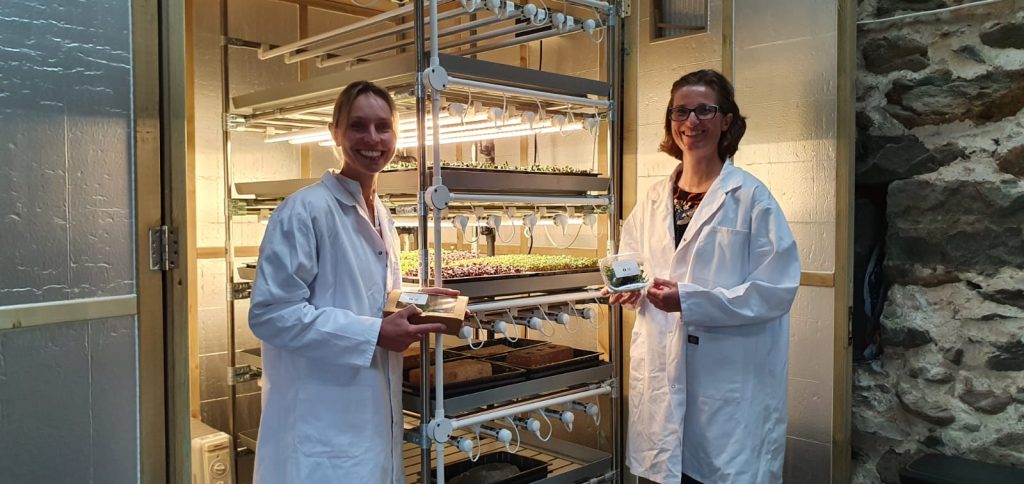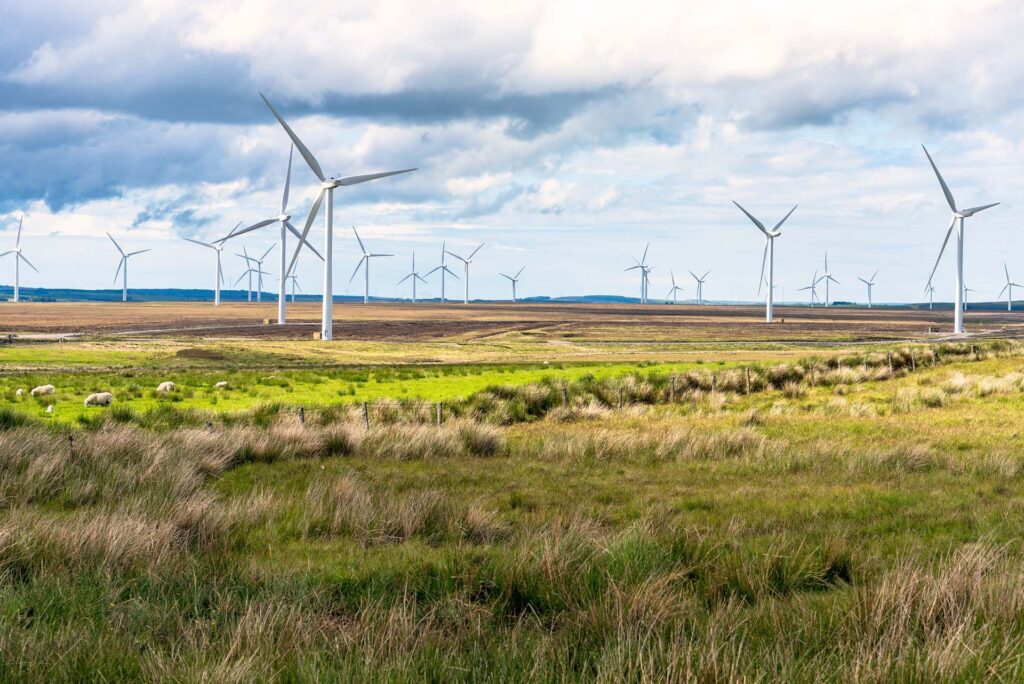Vertical farming. It’s the latest farming trend that’s been proving popular across the pond in the US and is a market that’s expected to grow exponentially as the decade goes on.
The method is quickly emerging as a farming technique in the UK, and it’s been reported that Gloucestershire could soon be home to the world’s largest vertical farm. Can vertical farming techniques work in tandem with traditional agriculture?
Here in North Wales, the Tech Tyfu pilot scheme launched in Spring 2020 and following the project’s success the Tech Tyfu Scale Up project launched in Spring 2022. The scheme initiated an exciting step forward in the practice of vertical farming in North Wales.
In this blog, we’ll explore what vertical farming is, how the Tech Tyfu project has placed North Wales on the map for vertical farming and whether it will become a significant part of the future of agriculture.
What is vertical farming?
While it may seem a novel farming technique, it’s in fact an ancient agricultural practice that dates back to the Babylonians who built their hanging gardens nearly 2,500 years ago, which many point to as the earliest type of vertical farm.
After a two millennia absence, the concept was allegedly re-born back in 1999 at Columbia University’s Public Health School, when a professor stumbled upon the idea while leading a course project that aimed to feed 50,000 Manhattanites.
Meanwhile, on this side of the Atlantic, vertical farming methods were first used by a company called Growing Underground, who operate sustainably out of a former air raid shelter below the streets of Clapham.
Today, the practice takes full advantage of modern commercial greenhouses (and other spaces) with rows of crops placed on top of one another in ‘stacks’ but with ample space for crops to grow. In these spaces, LED lighting either enhances or replaces the natural sunlight which means that the amount of light that crops are subject to can be manipulated to boost growth.
With plants grown in completely enclosed conditions, vertical farming can employ a system called ‘closed-loop water recycling’ which sees water repurified and recirculated to reduce waste.
When the North Wales climate is against us the vertical farming method allows crops still to flourish in a controlled environment where the amount of light and heat are controlled to optimum levels
The Tech Tyfu project
Tech Tyfu is a controlled environment agriculture programme (CEA) run by the not-for-profit social enterprise Menter Môn, which is based in Llangefni, Anglesey and delivers projects across North West Wales.
The project uses hydroponic vertical farming techniques, with the aim of exploring CEA’s potential for use in fresh food supply chains, and as a basis for educating and enhancing research.
In a previous blog, we looked at the Tech Tyfu project after Helen and Jodie were given the use of a V-Farm vertical farming unit which helped support the growth of their micro business, Tyfu’r Tyddyn
Vertical farming, according to Tech Tyfu, will help Wales better adapt to food supply chain challenges and offers rural business diversification opportunities. Baileys and Partners are well known for their proof-of-concept projects and the team often invest in areas they advise on, vertical farming being one of those areas.
Tech Tyfu’s pilot scheme which started in 2020, saw aspiring growers including businesses receive a year’s free use of one vertical farming unit, with many successfully establishing supply chains for their fresh food. Tyfu’r Tyddyn was one of those start up businesses.
This spring, the project launched its ‘Scale Up’ scheme which offers businesses and individuals the chance to use vertical farming equipment and attend workshops to help scale-up their vertical farming to develop supply chains.
Tech Tyfu’s Innovation Hub is also an important aspect of the project, and it aims to help embed vertical farming into the Welsh economy at a research facility at Menai Science Parc.
The benefits of vertical farming
There were previously large barriers to entry for intensive indoor agriculture with high start-up costs and energy bills making it financially difficult but in recent years, increased efficiency and falling manufacturing costs of LEDs has meant that vertical farming has become a far more cost-effective venture.
When it comes to crop yield, vertical farming is proven to be more productive than traditional growing methods as naturally, there are no adverse weather conditions to disrupt growth.
In environmental terms vertical farming has no impact on soil and native ecosystems in the countryside, which could mean more opportunities for the conservation of flora and fauna.
What are the disadvantages of vertical farming
Vertical farming is not without its drawbacks. Barriers to entry may be lower now but it is not considered that production can be scaled up to the level of field production on traditional rural farms.
This kind of farming requires far more energy than traditional farming methods due to the dependency on LED lighting and although LED lighting prices have reduced, energy costs have increased and with the high prices of energy it can be financially challenging to operate a vertical farm.
Is vertical farming the future?
The work being done at Tech Tyfu shows that with vertical farming the Welsh food industry can better adapt to supply chain difficulties and provide benefits to the economy.
It can be argued that environmentally the closed loop growing cycle and the fact that for many crops there is no need for fertiliser means that the practice is less polluting than traditional horticultural production.
Additionally, the high barriers to entry are seemingly being lowered which means more businesses can use vertical farming techniques.
However, high energy consumption and, by virtue, costs could leave many businesses viewing the technique as too costly given the energy price hikes, which may stifle vertical farming’s growth. Although many producers are choosing locations where surplus heat from other businesses is used or linking with renewable energy production to control costs.
Long-term, it’s hoped that vertical farming could work in tandem with traditional agriculture to improve the food industry’s supply chain adaptability and provide benefits to the economy both in Wales and the rest of the UK.
CLA AGM and Tech Tyfu Growers’ Event
On the 17th October, Baileys and Partners Jodie and Helen are due to be presenting on the subject of vertical farming at the CLA AGM and providing insights into this method of farming.
The pair will then be presenting at the Tech Tyfu growers’ event on 19th and 20th October, where they will share their experiences about operating Tyfu’r Tyddyn from one of the V-Farm units and explaining how the project can be used by other businesses.
Baileys and Partners has considerable expertise in the agricultural sector and can provide specialist farm business consultancy. They are well versed in vertical farming and can help any rural business thinking of venturing into this arena.
Find out more about Baileys’ expertise here.








2 Comments. Leave new
An interesting concept, I like the idea that there is no need for the use of fertilsers and that agri land could be freed up for ‘rewilding’ and other benefits to the ecosystem, it may lessen our reliance on imports in some areas too. I am a bit suspicious of the hike in potential energy consumption though, but where this can be sourced from renewables or surplus heat, then that would be better, not only to benefit the grower economically, but also the environment as less climate impacts. One thing we could all do though, is limit our consumption, eat within our means, and have less waste.
We see vertical farming working in tandem with traditional farming methods. Therefore ensuring that we become self sufficient with our fresh food demands throughout the year. Fortunately our vertical farming system is supported by renewable energy however for many renewable energy is cost prohibitive (capital costs and planning) and is viewed as a barrier to entering vertical farming. We agree that vertical farming supported by renewable energy is the way forward with the addition of producing food through traditional farming methods.